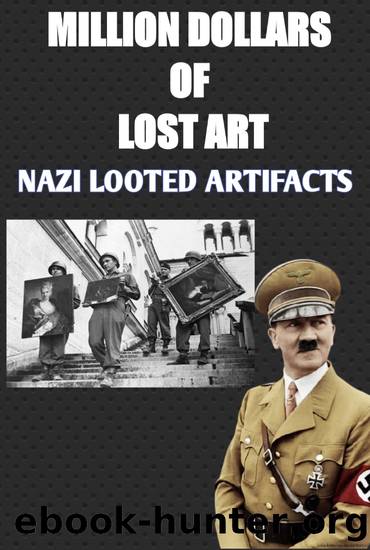MILLION DOLLARS OF LOST ART: THE STORY OF NAZI LOOTED ARTIFACTS by Elina Palmer

Author:Elina, Palmer
Language: eng
Format: epub
Published: 2021-06-13T16:00:00+00:00
1.4
Concluding Remarks on the Material Norm
Inconsistencies in outcomes, as seen in the categories of âearly salesâ, âsales by art dealersâ
and â Fluchtgutâ sales, illustrates that there exists no clear definition of what is considered an unjustified taking (âNazi confiscationâ) within the context of the âjust and fairâ rule. In addition to establishing what constitutes a âforced saleâ â and the limits of that concept â
there are many other difficulties in determining a âjust and fair solutionâ. How, for example, to deal with the interests of a new possessor, who may have acquired the artefact for a considerable sum of money and in good faith (as in the French Pissarro case noted in the introduction)? Furthermore, how should earlier compensation or settlements influence the outcome of present-day claims?
And on another note: is it justifiable to take into account the interests of the general public in cases involving important works of art in museums, in line with the internationalist Semmel collection regarding The Landing Stage by Van der Hulst in the Groninger Museum, and RC 1.75 of 1 July 2009 regarding Semmel), the artefacts were returned. This is explained by a difference in policy lines between cases that concern the Dutch State collection of heirless art and cases concerning other collections. In the latter category, the Committee balances the interests of the parties, while in the category concerning the heirless art collection, the policy is more lenient.
86
(RC 3.128), (RC 3.131) and (RC 3.126). As explained, the committee recommended restitution only in the case (RC 3.126).
87
Toledo Museum of Art v. Claude George Ullin, et al., No. 3:06 CV 7031, US Dist. N.D. Ohio, 28
Dec. 2006, at 7. Concluding: âDefendants [the Nathan heirs, EC] can prove no set of facts that entitle them to relief.â
88
Detroit Institute of Arts v. Ullin, Slip Copy, 2007 WL 1016996 (E.D. Mich. 2007). For a pending US âFluchtgutâ case see Zuckerman v. The Metropolitan Museum of Art, Index No. 1:16-cv-07665, Complaint, U.S. Dist. (C.D. New York, S. D., 30 Sept. 2016).
(or âuniversalistâ) notion in the cultural property debate?89 How to see, for example, the disappearance of an iconic painting like the Klimt portrait of Adele Bloch Bauer II from public display?90 If the interest of the general public would be considered a relevant factor in the setting of dispute resolution regarding Nazi-looted art, those interests would amount to an argument against the return of such works to private ownership. In that view, a financial settlement would be the preferred solution over restitution by a museum into private hands, as is often done in practice. This in turn raises another question, particularly if compensation was previously awarded in the post-war period under the provisions of the Settlement Convention mentioned above: when will a case be settled definitively?
Every case is different and, as such, alternative procedures, with the flexibility to accommodate creative and fact-specific solutions, may be needed. This also requires the availability of neutral and transparent procedures to further develop the fair and just norm.
However, at a procedural level, there
Download
This site does not store any files on its server. We only index and link to content provided by other sites. Please contact the content providers to delete copyright contents if any and email us, we'll remove relevant links or contents immediately.
| Africa | Americas |
| Arctic & Antarctica | Asia |
| Australia & Oceania | Europe |
| Middle East | Russia |
| United States | World |
| Ancient Civilizations | Military |
| Historical Study & Educational Resources |
Magic and Divination in Early Islam by Emilie Savage-Smith;(1498)
Ambition and Desire: The Dangerous Life of Josephine Bonaparte by Kate Williams(1342)
Bohemians, Bootleggers, Flappers, and Swells: The Best of Early Vanity Fair by Bohemians Bootleggers Flappers & Swells- The Best of Early Vanity Fair (epub)(1341)
Papillon by Henry Charrière(1305)
Twelve Caesars by Mary Beard(1253)
Operation Vengeance: The Astonishing Aerial Ambush That Changed World War II by Dan Hampton(1134)
What Really Happened: The Death of Hitler by Robert J. Hutchinson(1126)
London in the Twentieth Century by Jerry White(1110)
Time of the Magicians by Wolfram Eilenberger(1084)
Twilight of the Gods by Ian W. Toll(1083)
The Japanese by Christopher Harding(1081)
Lenin: A Biography by Robert Service(1041)
The Devil You Know by Charles M. Blow(983)
A Social History of the Media by Peter Burke & Peter Burke(936)
Freemasons for Dummies by Hodapp Christopher;(921)
Napolean Hill Collection by Napoleon Hill(901)
Henry III by David Carpenter;(890)
The Churchill Complex by Ian Buruma(879)
The Rise and Triumph of the Modern Self by Unknown(877)
